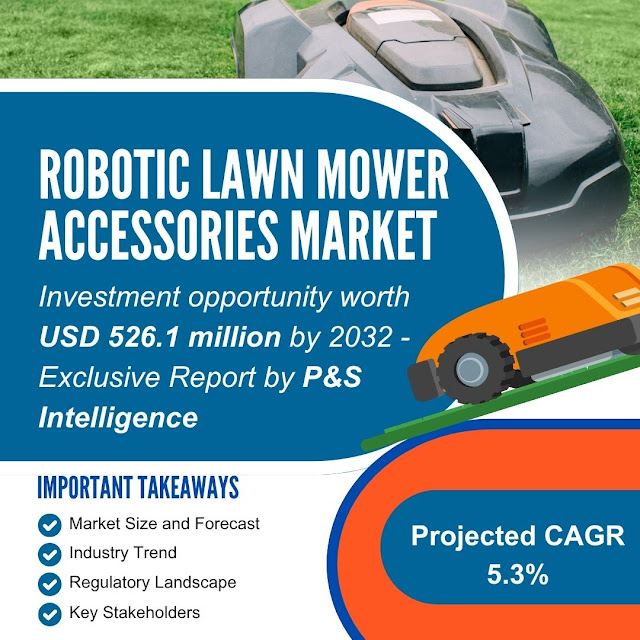The robotic lawn mower accessories market is experiencing steady growth as smart home technology transforms traditional lawn care practices. Valued at USD 352.1 million in 2024, the market is projected to reach USD 526.1 million by 2032, advancing at a compound annual growth rate (CAGR) of 5.3% during the 2025-2032 period. This expansion reflects the growing adoption of automated lawn care solutions and the increasing sophistication of robotic mowing systems.
Smart Lawn Care Revolution
The rise of robotic lawn mowers has fundamentally changed
how homeowners approach yard maintenance, creating a thriving ecosystem of
accessories and complementary products. These automated systems offer
convenience, efficiency, and consistent results that traditional mowing methods
cannot match. As robotic mowers become more mainstream, consumers are investing
in accessories that enhance performance, extend functionality, and protect
their automated lawn care investments.
The accessories market encompasses a diverse range of
products including replacement parts, protective covers, charging stations,
boundary wire systems, security devices, and performance enhancement tools.
Weather protection accessories such as garage shelters and covers are
particularly popular, as they extend equipment lifespan and ensure consistent
operation across various climate conditions. Safety and security accessories,
including GPS tracking devices and theft deterrent systems, address growing concerns
about protecting valuable robotic equipment.
Market Drivers and Consumer Adoption
Several factors are driving robust growth in the robotic
lawn mower accessories market. The increasing adoption of smart home technology
has created consumer expectations for automated solutions that integrate
seamlessly with connected home ecosystems. Homeowners are embracing the
convenience of hands-free lawn maintenance, particularly as busy lifestyles
leave less time for traditional yard work.
Demographics play a crucial role in market expansion, with
aging populations in developed countries seeking solutions that reduce physical
demands of lawn care. Additionally, younger homeowners who grew up with
technology are more likely to adopt robotic lawn care solutions and invest in
accessories that optimize performance. The growing awareness of environmental
benefits associated with electric robotic mowers is also contributing to
increased adoption rates.
Property development trends are supporting market growth,
with new construction often incorporating larger lawns and complex landscaping
that benefit from automated maintenance solutions. Homeowners with premium
properties are willing to invest in high-quality accessories that ensure
optimal performance and protect their landscaping investments.
Technology Integration and Innovation
Modern robotic lawn mower accessories are becoming
increasingly sophisticated, incorporating advanced technologies that enhance
user experience and system performance. Smart charging stations with weather
monitoring capabilities, mobile app connectivity, and energy management
features represent the cutting edge of accessory innovation. These products
enable remote monitoring, scheduling optimization, and predictive maintenance
capabilities.
GPS tracking and security accessories have evolved to
include smartphone integration, real-time alerts, and sophisticated anti-theft
mechanisms. These accessories address one of the primary concerns potential
buyers have about robotic lawn mowers, making the technology more attractive to
security-conscious consumers.
Boundary wire systems and installation accessories have
become more user-friendly, with improved materials and simplified installation
processes that reduce setup complexity. Professional installation services and
DIY-friendly accessories are expanding market accessibility to consumers who
might otherwise be hesitant to adopt the technology.
Seasonal Demand and Maintenance Requirements
The robotic lawn mower accessories market exhibits distinct
seasonal patterns that influence sales cycles and inventory management. Spring
and early summer represent peak demand periods as homeowners prepare their
automated systems for the growing season. Replacement parts and performance
accessories experience highest demand during active mowing seasons, while
protective covers and storage solutions see increased sales as winter
approaches.
Maintenance accessories including blade replacements,
cleaning tools, and diagnostic equipment generate consistent demand throughout
the operating season. The recurring nature of these purchases creates stable
revenue streams for accessories manufacturers and retailers. Battery
replacement and charging system upgrades represent significant market segments
as early adopters of robotic mowing technology require equipment updates.
Distribution Channels and Market Access
The robotic lawn mower accessories market benefits from
diverse distribution channels that serve different consumer segments. Online
retail platforms have become increasingly important, offering comprehensive
product selections and detailed compatibility information that helps consumers
identify appropriate accessories for their specific mower models. E-commerce
platforms also enable direct-to-consumer sales from manufacturers, improving
margins while providing detailed product information.
Traditional retail channels including home improvement
stores, garden centers, and specialty lawn care retailers continue to play
important roles in market distribution. These channels provide hands-on product
evaluation opportunities and expert advice that many consumers value when
making accessory purchases. Professional landscaping services represent another
significant distribution channel, particularly for commercial-grade accessories
and installation services.
Regional Market Dynamics
North America and Europe represent the largest markets for
robotic lawn mower accessories, driven by high adoption rates of automated lawn
care technology and strong consumer spending on home improvement products.
Suburban landscapes with medium to large lawns create ideal conditions for
robotic mower adoption and subsequent accessory purchases.
The Asia-Pacific region is emerging as a significant growth market, with rapidly expanding middle-class populations and increasing focus on convenience technologies. Countries like Japan, South Korea, and Australia are experiencing particularly strong growth in robotic lawn care adoption, creating opportunities for accessories manufacturers.














